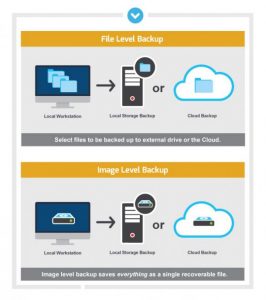
Backup and recovery procedures protect your data against data loss and reconstruct the data, should loss occur.
When searching for a backup solution, you’ll find that there are two main types of backups: “file-level backup” and “image-level backup.”
File-Level Backup
File-level backups are the most common type of backup. This method has been around for a long time, and most people are familiar with the process. File level backup allows you to save individual files and folders from your office computer to a remote location. You’ve probably used a consumer-level backup program to save files, such as Google Drive, Dropbox, or Microsoft Office Drive. Because only changed data is saved with each backup, the total backup is smaller in size and therefore requires less storage space.
For most SMBs, operating only a few machines or in a home computing situation, this type of backup is usually adequate for maintaining your data. Delete a file? Go and get it from your external drive or cloud storage solution.
Image-Level Backup
Image-level backup is known by many names: bare metal backup/recovery (BMR), disaster recovery backup, ghost backup, block-level backup or “cloning” your machine. Image level backup is a more complete option for backing up your practice data. Rather than copying individual files and folders, image level backup takes a snapshot of your entire operating system and all of the data associated with it. The backup is saved in a single file called an image, which can be retrieved and restored if your practice suffers a major data loss. This backup method requires more storage space, but it’s much more efficient when you want to get back up and running as quickly as possible.
Another benefit of image level backup is that the copy of your operating system can be restored to any computer. So, if your hardware is damaged due to a fire or flood, or if your computers are stolen, there’s no need to search for and purchase compatible older machines. And, while the main benefit of image level backup is having the ability to quickly restore your entire server from a single file, it’s also possible to retrieve a singular file – eliminating the need for file level backups.
Learn more about our A+ certification.







